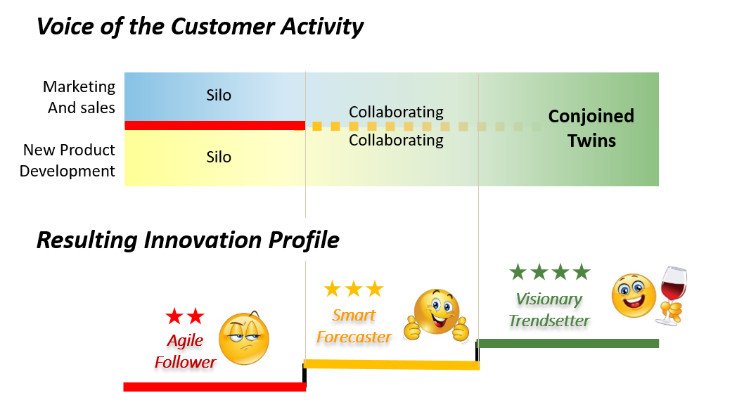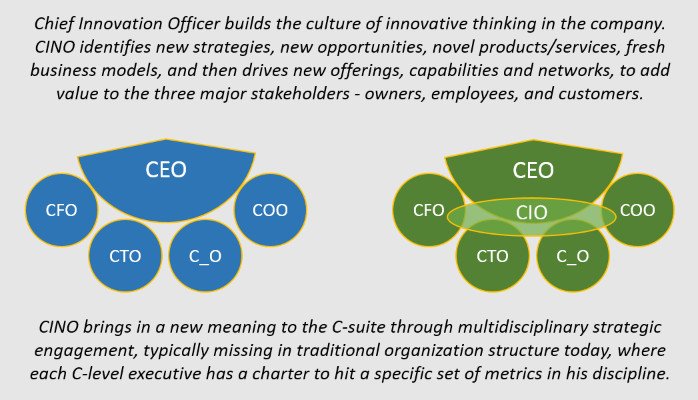VOC is more than a Voice for Innovators
Acknowledging my coauthor Bill McClain.
When your company wants to be THE industry leader, where do you focus your team?
Case Study 1: On the 4th day of a “5-Day Leadership Retreat on Building a Culture of Innovation”, the Engineering team conceived an achievable futuristic product specification in anticipation of the market, but an exercise without a formal Voice of the customer (VOC). Here is a snippet of the leadership conversation during the happy hour later that evening:
Lead Marketing, “Customers are actually discussing similar requirements, we didn’t bring it to engineering because we didn’t think we have the capability to do it.” (Oops! Bad assumption.) “We generally promote what engineering has made or bring an RFP when it is out in the open media.”
Lead Engineering, “We rarely sit back and do ‘possibility thinking’. We generally create products in response to Marketing bringing the requirements in as an RFP. If we believe that we can profitably make it within the customer required date, we bid on it.”
Hmm… You guessed it. They are working in silos and ‘in the past’ instead of ‘into the future’. A deep Voice of the Customer mindset needed to be established.
Imagine a scenario where Engineering and Marketing are playing from the same sheet of music, a “Product Roadmap”, an evergreen vision, or the living document. At any given moment, Engineering is creating a product for the future, and marketing is engaging the customer/consumer in the same future offering.
The dilemma to be resolved is when a company waits for a request for proposal (RFP), it is usually late for innovation, and when a company develops a product without proper VOC, the new product may miss the mark.
Approach to Voice of the Customer
One of the problems with VOC is its name. It’s too simple. People tend to assume that it means what the customer would ask for. But that river is much deeper. We will get into that, but for the moment let’s say it is getting into the customer’s head, and understanding it, at one of the three levels:
1. Understand their requirements – Gathering and analyzing data, without intervention (B2C) or tracking and interpreting RFPs, without any/substantial direct customer input (B2B); This is like listening to what customer is saying.
2. Anticipate their requirements – Gathering customer perspective or requirements by direct structured interviews, in anticipation of formal RFP or other demand cycles; This is like watching the body language of the customer and understanding faint signals of desire or unarticulated needs.
3. Lead them – Observing the customer closely to understand usage and interactions better, and experimenting with prototype, or beta release to a focus group of customer demographic (B2C). Analyzing customer products and services or end users to understand pains and gains, and developing a shared vision for the next generation products and working together on prototypes. This is like putting the words in the customer’s mouth.
A B2B Example: In a government or aerospace environment, suppliers are led by the prime. Here the VOC efforts are to ferret out the prime’s plans for the future with a concerted and coordinated effort to stay involved with the prime. In an environment where the supplier has a catalog of standard products, the supplier has a little more power and ability to influence the design.
A B2C example: In consumer products (CPG), the manufacturers drive the design fully and the role of VOC is to not only anticipate what the customer wants, but to use that freedom to make competitors irrelevant.
Clearly, VOC means more than what customer is asking for. It means interpreting what they would be willing to pay for. VOC, at its best, helps understand the market so well that the disruptive next step can be envisioned and produced. There are always small signals amidst lot of noise. People like Jeff Bezos, Bill Gates, Mark Zuckerburg, Steve Jobs, Elon Musk could hear very faint VOC, test the hypothesis, push the boundaries of innovation, and put words in the mouth of the customer.
VOC is more than what customers take away
VOC is also more than what product or service performance and features the customers take away form a purchase process. This even goes where they want to procure it (distribution), what they want to buy with it (bundling), what business model they want the supplier to use (rent/buy, IoT/monitoring services, etc), and all the buyer’s considerations in between. On-line retailers are encashing on millennial’s desire to not go to shop, irrespective of the product.
VOC is also more than a process in the Marketing Department to get customer input. It is intertwined with on-going company engagement culture improvements, and the most vital part of any innovation culture. VOC depends on rigorous exercising of the 3 Cs: Communications (clarity of expression), Company (agile processes to detect the customer’s unexpressed thoughts), and Customer (every company decision has to consider how that decision effects the customer). It is also more than the Marketing Department and the R&D Department. It is more than the company and includes the customers, suppliers and even competitors. It is a diverse and symbiotic eco-system of continual innovation. Amazon and Netflix are notable examples here.
Innovation Profiles
Companies adapt an innovation strategy in line with their culture, resource availability, risk-taking capacity, and VOC. Allow us to broadly define three different profiles based on how they engage the market.
Agile Follower – who innovates in response to market need, usually competing on cost,
Smart Forecaster – who innovates in anticipation of market demand, usually competing on performance, and
Visionary Trendsetter – who innovates and creates the market demand, making competition irrelevant.
By now, you should be able to see a 1:1 correlation between the three levels of VOC and the three innovation profiles, which distinguish the industry leaders and laggards.
Question – Is VOC the Primary tool for Innovation Profile Progression?
Case Study 2: A component manufacturer was about to go out of business, because they could never keep pace with the speed at which their B2B customer rolled out new products. Root Cause: Account Managers wait for RFPs from the customer’s purchasing department, and it is typically too late to address the development cycle time. Solution: Help supplier’s Engineering create a component roadmap aligned with the customer’s product roadmap and start the supplier’s R&D sooner to meet the customer’s product development time line.
Every company has its impediments to innovation. In the small company it may be the weekly need to meet the payroll. In the larger company, it could be the inbred culture of compliance to internal processes. These obstructions to innovation, indeed these assassins of innovation, must be recognized and eliminated.
Unfortunately, industry cultures, and some other factors tend to focus management energy on better known but less important issues, leaving innovation as a topic for soothsayers and fortune tellers. These proven and silo-istic approaches are the enemy to prospering in the “Era of Disruption”. An era where Artificial Intelligence, VR, 3D Printing, Robotics, Internet of Things (IoT), and a few dozen other leading-edge technologies are about to dramatically affect every business. A era where these technologies provide an opportunity for the company to render the competitors irrelevant.
Selfie time
Is your VOC activity in line with Innovation Strategy – Follower, Forecaster, or Trendsetter?
If your marketing and product development are operating in different silos, then you can at best hope to be an Agile Follower. Product Development and Marketing need to work as a conjoined twins in engaging with the customers, in a manner that looks at the evolving future together, drive both the product and business model innovation, and continuously enhance the value created for all the parties involved.
This article is co-authored by a Product Innovator (Ripi Singh) and Marketing Strategist (Bill McClain)


